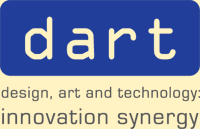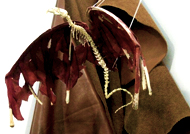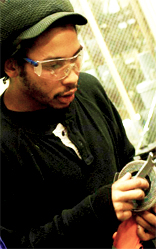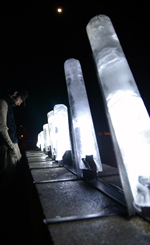Design, Art, Technology Grants for Innovative Student Projects

 |
A faculty review panel drawn from across the College selects the funded projects. The DART grants process not only supports innovative work at the intersection of design, art, and technology, but is also used to teach students the skills necessary for preparation of grant applications. Recipients receive up to $500 to support their projects.
Grant recipients and their projects are:
Lindsay Barbieri
but fire thought she'd really rather be water instead
Barbieri aims to bring NASA-caliber data into tangible form. Using sculpted wire to express time and mobile-like stained glass to represent development of stars, supernovas, and galaxies, her sculpture will merge science and art in a way that enhances both disciplines. The narrative thread through space and time will be the history of water on Earth and Mars. Embedded computer monitors will present geographic information, allowing viewers to interactively explore the geologic histories of both planets.
 |
Lanterns and Lungs, Bodies and Bones, Cloth and Carrying (left)
Brevik's wearable sculptures, built of bone, wire, cloth, and paper, contain LED lights (light emitting diodes). Wearers bring light to the sculpture, as the lantern lights glow and dim with the rhythms of their breath and pulse. Brevik is specifically interested in the ways in which human interaction alters an object's meaning and intent, and how animals are changed through their interactions with humans. He hopes the creation and use of his sculptures will enhance understanding of the connections between domestication and morphology.
Brigid Pasco
Untitled—Division III Project
Pasco is choreographing an integrative music and dance performance using the theremin sensor. The sensor is a digital incarnation of the theremin, a musical instrument that is played without being touched, with two antennas controlling pitch and volume. Often recognized as providing background music for early science fiction films, it is now being reinterpreted in new ways, as in this project. Dance movements of three choreographed performers will generate sound from theremin sensors, with those results combined with other digital samples to create a singular composition. Pasco's goal is to create an integrated art form that is not a dance, theater, or computer music performance, but rather a more holistic art experience.
 |
Mastering the Patina
Working with metal, sculptor Peters (left) creates animal and human forms through a diverse set of techniques ranging from blacksmithing to computer-aided milling. He is conducting a series of experiments to gauge the effect of various chemical compounds on the surface of steel. His goals are to expand the color palette available for finishing steel surfaces and to take his work in new directions through transformation of both form and surface.
Eric Peterson
Los Angeles: 1851-2043
Peterson's research project begins with the first Cartesian mapping of the city and crosses nearly two centuries of shape-shifting into the Los Angeles of today, and into its sci-fi future as plotted in Neal
 |
Sarah Tundermann
Coruscation (right)
Tunderman is a light artist with a background in theatrical lighting design. To explore the potential use of ice as a medium for exhibition lighting design, she merged ice sculpture, metal fabrication, and LED lights into a temporary installation on the Hampshire College library lawn. A scientifically calculated angle trapped the light inside the ice medium. As the ice disappeared, so did the sculpture.
Article Tags

